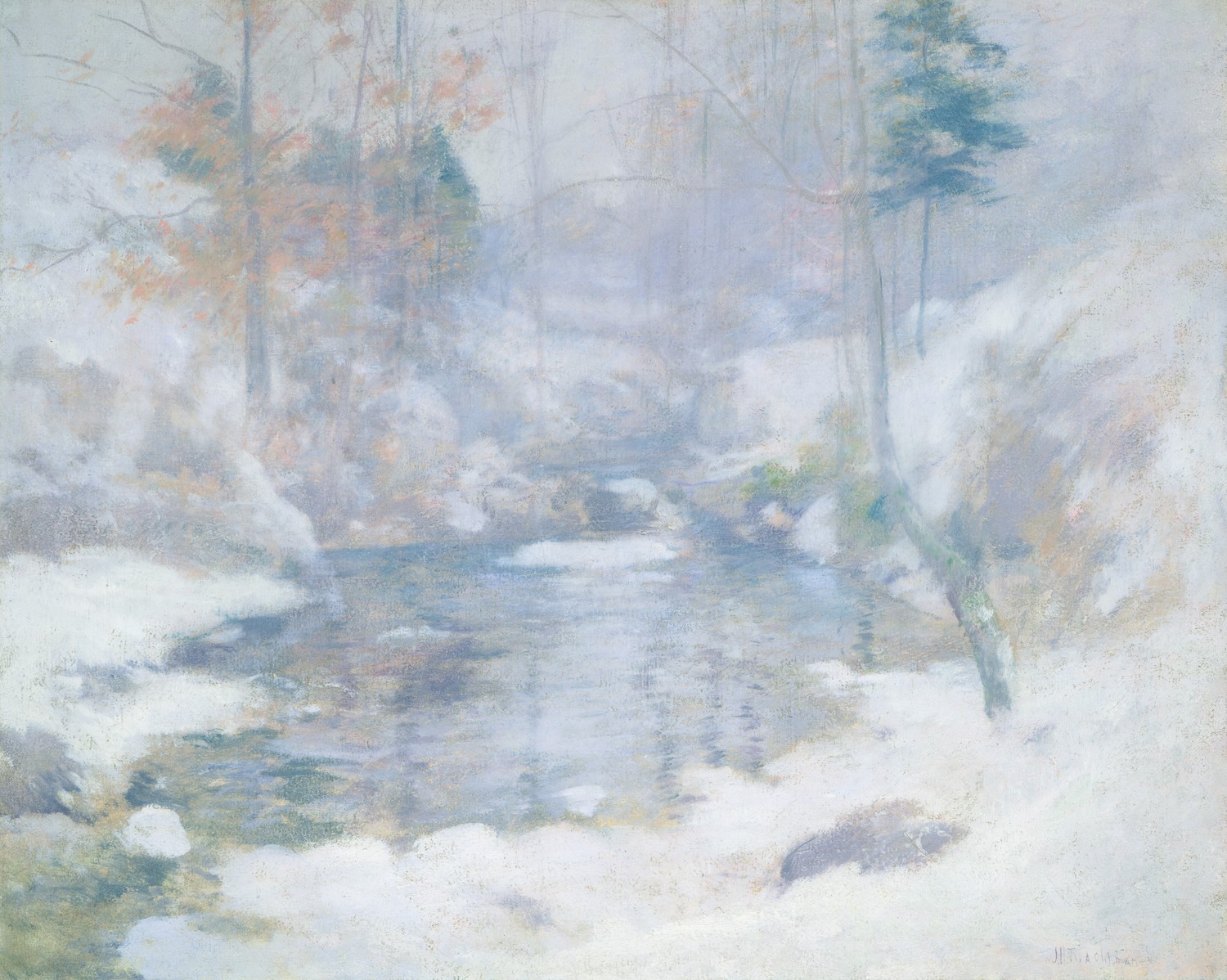
Recently I managed to miss a show I would very much liked to have seen: Life and Art: The Greenwich Paintings of John Henry Twachtman at the Bush-Holley House Museum in Cos Cob, home of the Greenwich Historical Society. Twachtman was one of our great landscape painters, an artist whose trajectory took him from Realism to Impressionism and Tonalism, though he really belonged to no school or movement, and was from beginning to end a painter of originality. He was connected, socially and creatively, with many of the best American artists of the era, from whom he derived and upon whom he exerted influence. What follows are an outline of his life, observations about his work, and, finally, some thoughts on his career as an instructor, particularly at the Art Students League of New York.
Twachtman was born in Cincinnati in 1853, in Over the Rhine, the city’s German district. As a teenager, he assisted his father decorating window shades, then attended art school for five years at McMicken School of Design. In 1874–5, he studied with Frank Duveneck at the Ohio Mechanics Institute. Twachtman met fellow students who would become prominent American artists, including Robert Frederick Blum, Kenyon Cox, and Joseph DeCamp, but he was not fond of Cincinnati, a city that despite rapid industrialization and growth, was conservative in matters of art. From 1875, Twachtman’s peregrinations began in earnest, and though his movement both within this country and overseas predate car and air travel, they represent a standard circuit for a serious American painter—and specifically, one from the German quarter of Cincinnati—in the latter half of the nineteenth century.
In 1875, Twachtman accompanied Duveneck to Germany and enrolled in classes at the Munich Royal Academy. Munich was then perhaps second only to Paris as an international destination for art students. A few years earlier, William Merritt Chase had been a classmate of Duveneck there, and in 1877, Twachtman joined them in Venice. He returned to the States in 1878 and bounced between Cincinnati, where he taught at the Women’s Art Museum Association, and New York City, where he kept a studio that also served as a base for painting trips along the eastern seaboard. In 1880, Twachtman left for Florence, and taught at an art school Duveneck had recently opened there. The following year, he married fellow artist Martha Scudder in Cincinnati; they honeymooned in Europe, meeting up with his friend J. Alden Weir, then returned to Cincinnati.
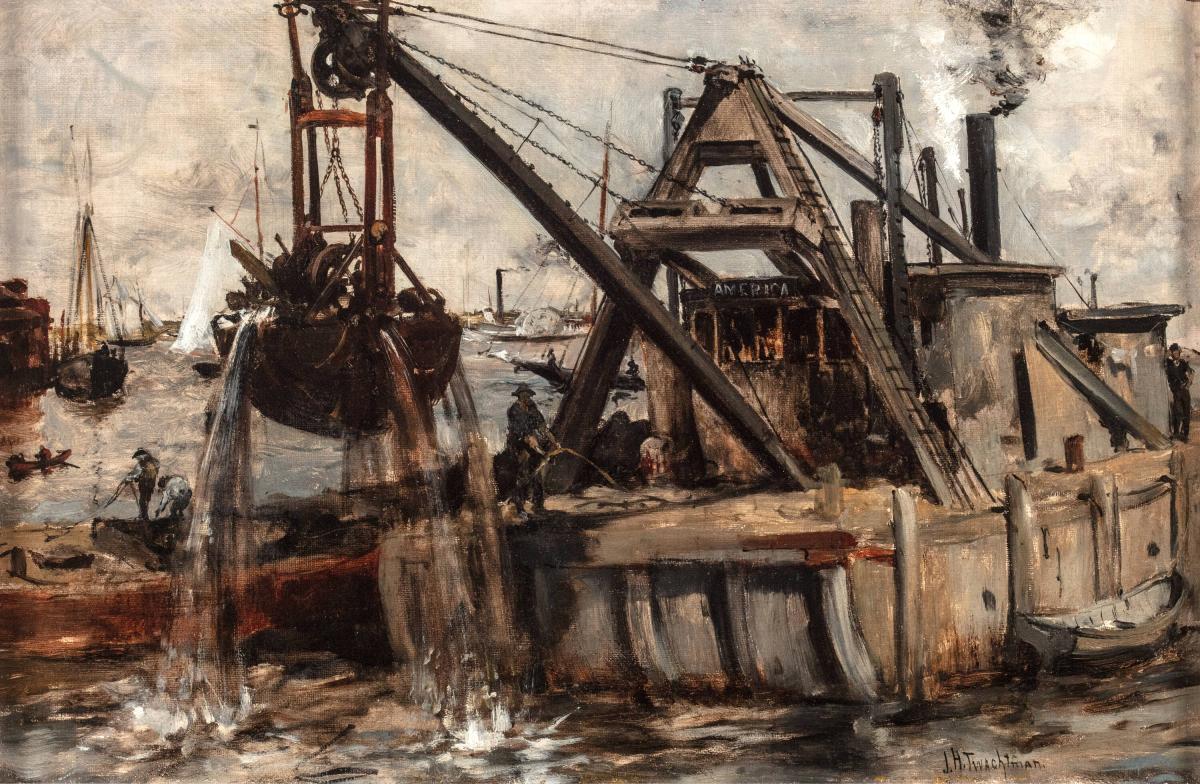
Neither family life nor professional responsibilities slowed Twachtman’s travels, nor impeded his desire for further study. Though he was exhibiting regularly to positive notice, from 1883 to 1885 he took classes at the Académie Julian in Paris, where he refined his drawing skills and befriended a who’s who of notable American students. As noted, the frequent crisscrossing of the Atlantic, with side trips to Italy and Holland, was routine procedure for an ambitious artist at that time (by contrast, when I had the summer off from the League a hundred years later, a week or two of landscape painting upstate seemed like heaven). Twachtman returned to the U.S. in 1886, more or less for good. After lengthy visits to Weir’s home in Branchville, Connecticut, in the fall of 1889 Twachtman settled in Greenwich. It is the Connecticut landscape, painted year round but most especially in winter, with which Twachtman has come to be identified. The tonal harmonies of the 1890s constitute one of the great suites of the intimate American landscape. “I feel more and more contented,” he wrote Weir, “with the isolation of country life. To be isolated is a fine thing and we are all then nearer to nature. I can see how necessary it is to live always in the country—at all seasons of the year.”
Notwithstanding nuances and outlying examples, the phases of Twachtman’s painting can be oversimplified to three periods: Munich Realism, French Salon, and finally, American Impressionism. Twachtman’s early works do share characteristics with the painting of his maturity, particularly in a fondness for two-dimensional pattern and evocative mood. An ability to pare the inessentials from a composition was advantageous for pastel and printmaking as well, with broad sections of the paper left empty, and he sometimes carried small etching plates for spontaneous work on site. Twachtman’s painting was considered modern at both ends of his career for different reasons; the work from the 1870s on the basis of content, the inclusion of man’s industrial presence, and the late work for its abstraction. Though Whistler is credited with discovering the backwater views of Venice previously ignored by artists who focused on well-worn scenery, Twachtman actually preceded him in this respect by several months. Most artists went to Venice to escape the modern world. When he painted the Grand Canal in 1878, Twachtman placed at the center of the composition not the usual gondola, but a black steamboat. In 1879, he brought the same sensibility and greater skill to a ripe locale, the New York waterfront. Dredging the Harbor is an astonishingly powerful small canvas, a premonition of the Ashcan School. There may be no comparable paintings of industrial New York from that era. The Cincinnati landscapes of the early 1880s are similarly rough hewn, energetic in handling and structured by value contrasts.
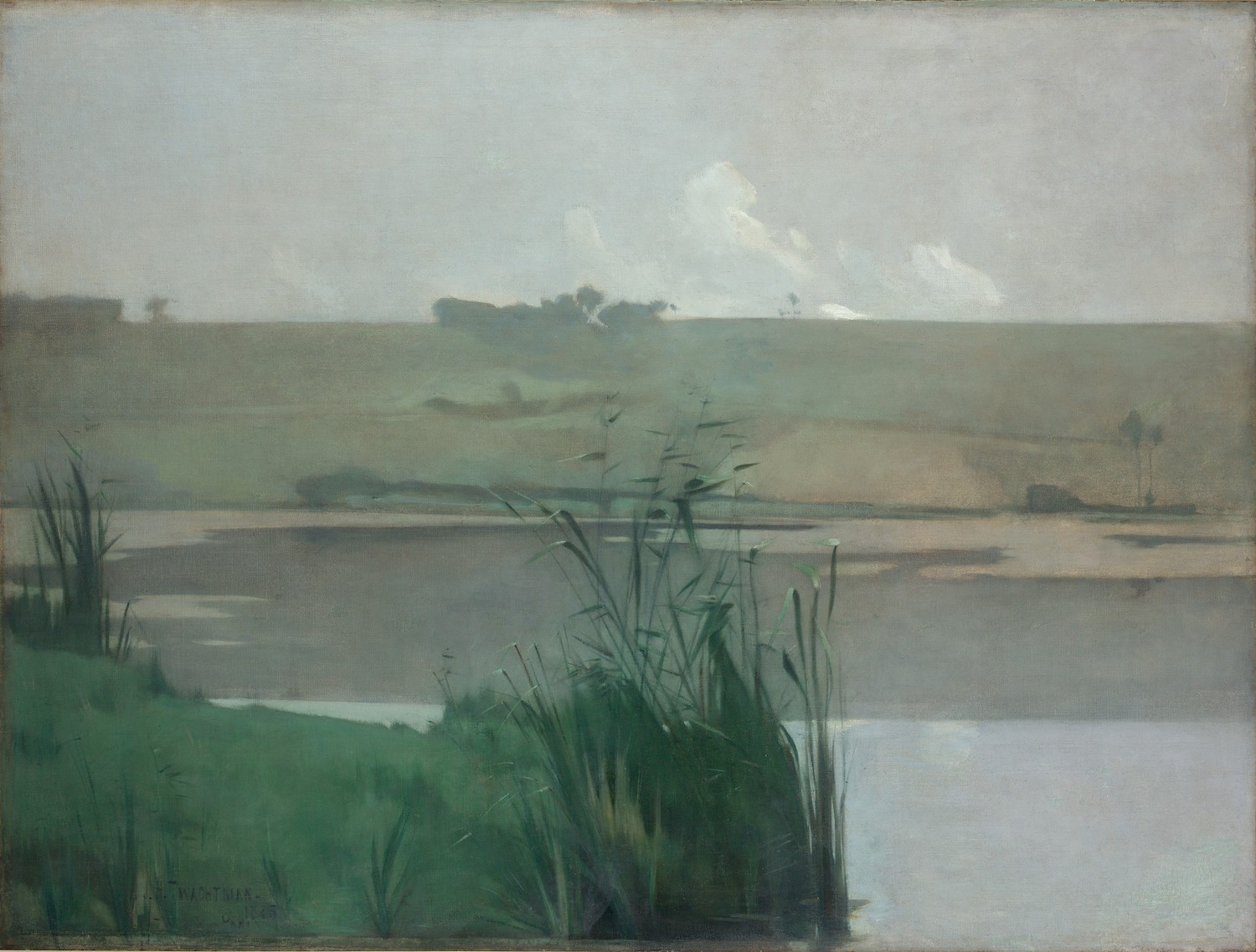
While studying in France, Twachtman made a conscious choice to jettison his previous approach. The paintings of the mid-1880s are characterized by abstraction, atmosphere, and sublimation of brushwork. The so-called diploma piece of his French style was the large Arques-la-Bataille, a tranquil scene at the eponymous town in Normandy. Arques-la-Bataille is a highly refined studio piece, an enlargement of a smaller oil that was painted on site. The canvas may be as close to “life size” as a landscape can get—standing before it, one is both invited to enter the scene and halted by its soft focus artifice. Of a sudden, as if to prove he could do it, Twachtman tried on the immaculate surface of salon painting. What surprises me is that he felt it necessary to add to his student resume, after five years in Cincinnati, plus the time with Duveneck and then the Munich training. Twachtman was discerning of instructors and wary of the intent to replicate nature. He appreciated the art of Jules Bastien-Lepage, who was then exceedingly popular with American students, but correctly assessed his art as rarely going “beyond the modern realism which…consists too much of the representation of things.” In France, Twachtman was moving toward a personal, poetic expression that would culminate in his work of the 1890s.
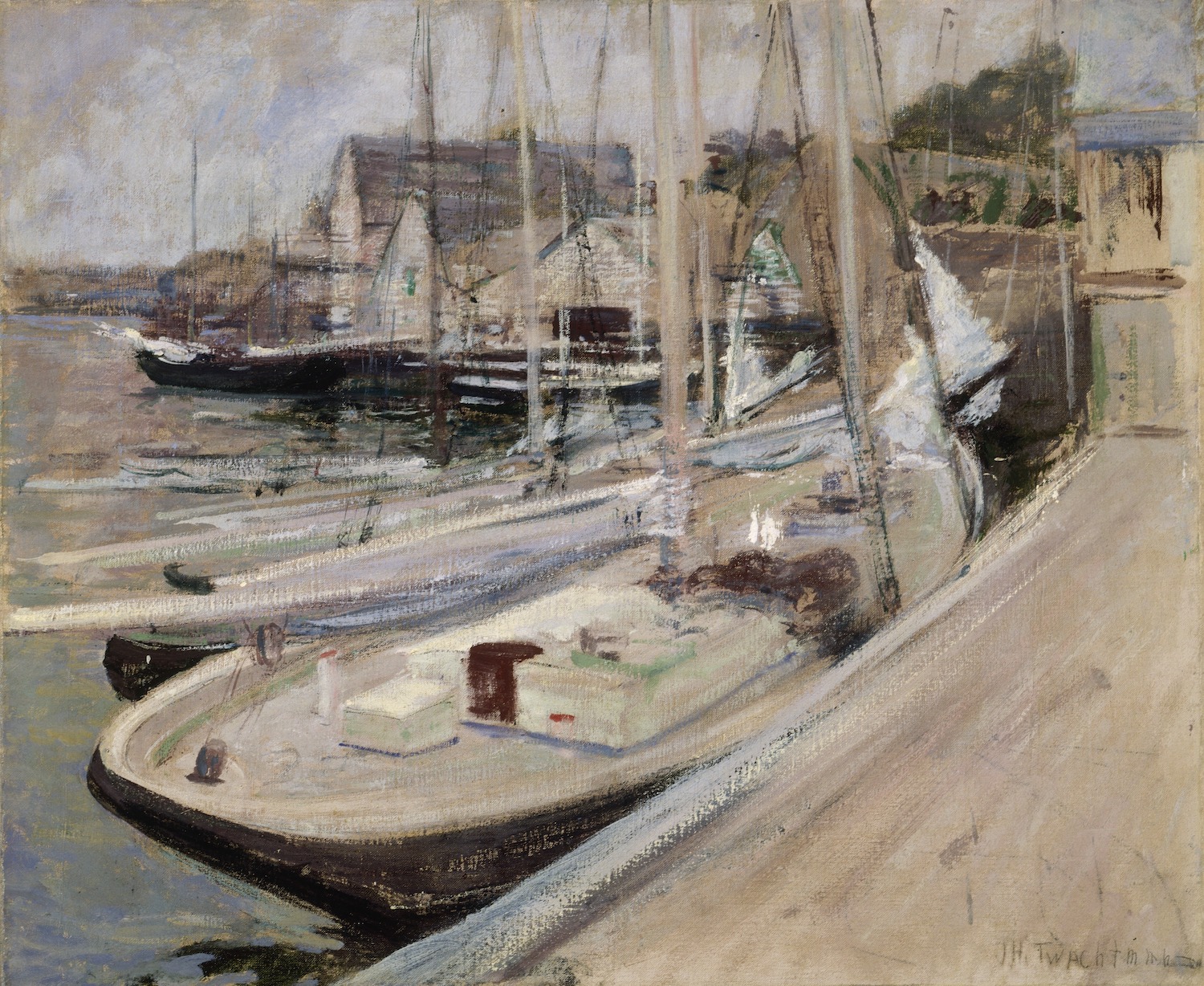
When Twachtman returned to this country, he once again adopted a rougher paint surface, but it was less impetuous than the work he had done under the Munich influence. Writing about an unfinished painting, his biographer Lisa N. Peters noted that he “blocked in the entire structure at once, using broad hatchings to indicate tonal values,” and would have continued building forms with thicker paint and emphatic lines. Some paintings momentarily brushed off the dreamlike atmosphere that came to define his vision, like Connecticut Shore, Winter, a brilliantly designed study of light and shadow that tacks toward the realism he generally avoided. Later still, he was drawn again to the hard-edged geometry of the dockside in Fishing Boats at Gloucester; a recurring interest in maritime and architectural themes provided welcome pictorial structure and staccato contrasts.
The significance of the visits to Weir’s farm in Branchville can hardly be overstated. From his friend’s front porch, Twachtman painted a canvas even larger than Arques-la-Bataille, a panoramic rural view as loose and fiercely energetic as the French picture was controlled. It fairly announced Twachtman’s decision to relocate to the country. Initially he rented a summer home nearby, and while he and Weir painted their children played together. Soon enough he purchased a property with a brook and small waterfall in Greenwich. Twachtman and his family settled there in 1889, and from thereon, except for a few summer trips to Gloucester, he rarely painted outside Greenwich. He painted the brook in all seasons, sometimes from a slight distance that shows its meandering course, as in The Torrent, at other times up close, as in Horseneck Falls, exploring the falls’ gentle switchback as an intimate response to “the isolation of country life.”
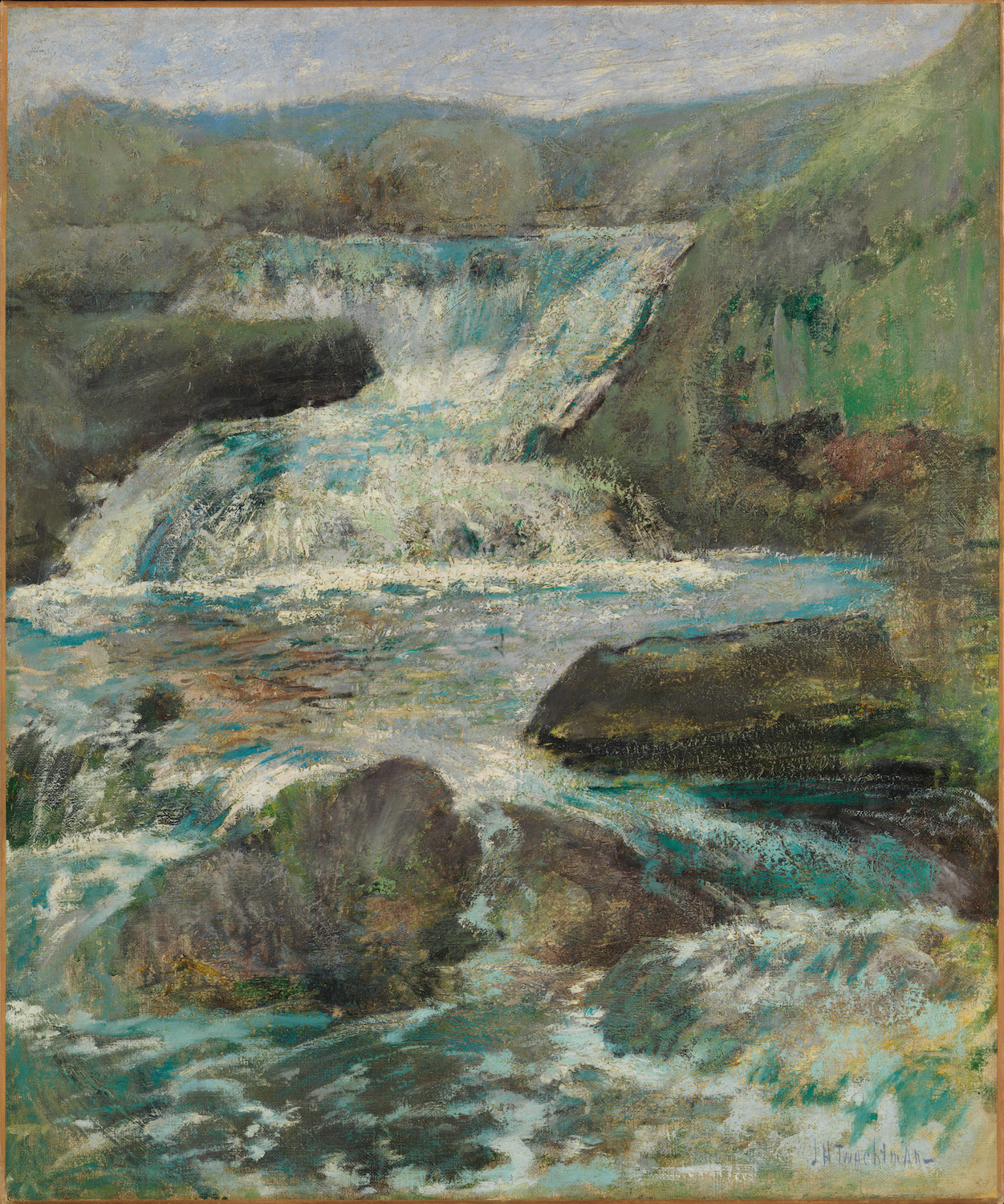
The dense accretion of pigment in these paintings provides an internal solidity, rather than one conferred by light and shadow, suggesting many sessions of patient observation (I like that density, and that once he’d taken a shot at academic painting in France he was willing to break with the temptation of “modern realism.” Weir went through something similar, which may explain some common ground for their friendship. Each adopted the hatched strokes of Impressionism, which they wove like tapestries). The final period at Greenwich was immersive, the paintings an expression of proximity to nature as a spiritual unfolding. Spirituality was a big theme in American landscape painting during the nineteenth century, and Twachtman, like Inness, doesn’t hit us over the head with the concept. It’s baked into his painting.
This is not to suggest that Twachtman was a recluse. His presence was central to the Cos Cob Art Colony’s “raucous gatherings” at the Holley House, which included prominent writers as well as major American Impressionists. It was also close to New York City. The express train was five minutes faster from Greenwich to the city than it is now. This was important because Twachtman taught at Cooper Union and the Art Students League of New York. He taught elsewhere: in Cincinnati, for Duveneck in Florence, Newport, Cos Cob (often with Weir), East Gloucester, and at the League’s first summer session in Norwich, Connecticut, with Bryson Burroughs. But it was the Art Students League of New York that provided Twachtman the most consistent employment. Twachtman started teaching at the League in 1889, as instructor of the preparatory antique class, and continued to teach until his death in 1902. Peters cites the recollections of a class attendee:
Twachtman advised his students to forgo a literal interpretation of nature, to paint in new ways that avoided formulas and overused methods…. Twachtman advocated a concentration on large masses, an elimination of excess detail, and the idea that simple forms should be studied and represented life-size or in broad terms. Twachtman’s most vehement recommendations were that artists develop their own ways of seeing and distill the essential qualities in nature, omitting distracting details.
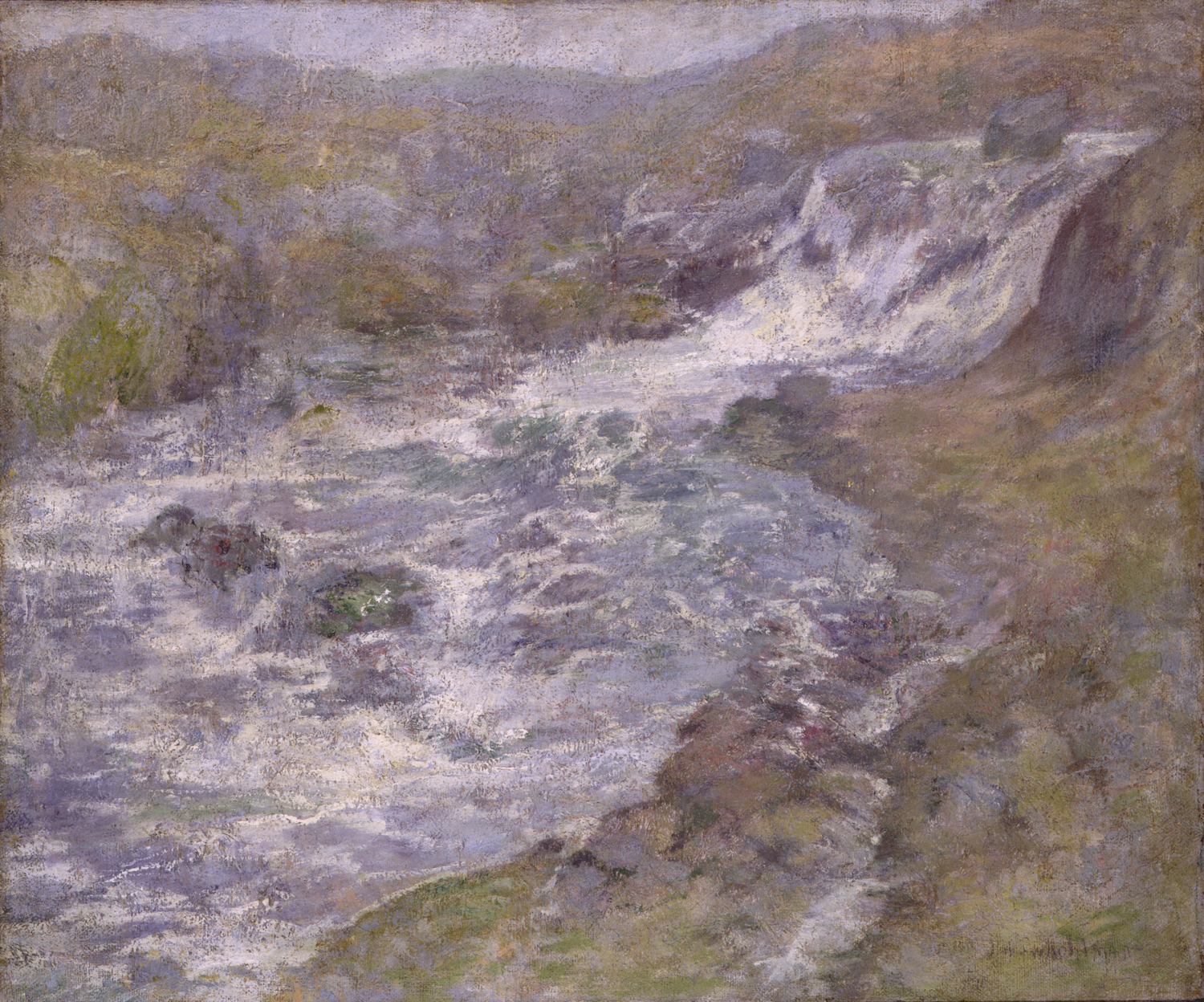
The preparatory antique class was entry-level, its curriculum based on drawing parts of casts; upon “graduation,” students moved on to the antique class and were permitted to draw casts of the whole figure. A student described Twachtman as “a poet made to drag a cart, heavy with blocks of plaster.” The New York classes were a far cry from his summer landscape courses at Cos Cob, in which “the art student vigorously wields the paint brush or lazily dreams in the hammock under the apple trees.” Twachtman was less interested in imparting classical ideals than in encouraging his students to study the casts for line quality and value. One imagines that those students who shuttled between New York and Cos Cob realized they were learning the same principles, whether the subject was landscape painting or cast drawing.
It seems counterintuitive—to put it diplomatically—to install one of the most visionary landscape painters of his time as an instructor of introductory cast drawing. However, the League had no landscape painting classes in the late nineteenth century. And there’s no indication that teaching slowed his output or compromised the quality of his painting. To the contrary, Twachtman’s tenure at the League, which correlated exactly to his time in Connecticut, may have helped to sharpen his focus when he stepped off the train in Greenwich. Awaiting him at home were a growing family, the company of artists, and a property whose topography provided continuing inspiration. For over a decade, Twachtman’s home on Round Hill Road was one of the charmed sanctuaries of American art.




